The Nonsense Machines of Maywa
Denki
The Inventor Series > Dr. Nakamats > Thanko > Maywa Denki
The Captain's
first experience in electronics goes back to his work on the
legendary learning tool the Speak & Spell. Do you remember
the first time you typed "N-E-I-G-H-B-O-R" onto
the keypad? Well, the Captain was right there with you. Yes,
voice-over work has been one of his many pursuits.
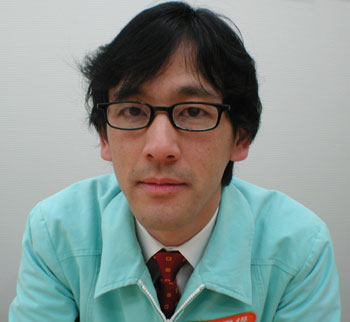 This
week he is immersing himself into the switches and capacitors
that make up the art and music group Maywa
Denki. Put those headphones on - it's bebop time.
This
week he is immersing himself into the switches and capacitors
that make up the art and music group Maywa
Denki. Put those headphones on - it's bebop time.
A crowd has gathered around
Nobumichi Tosa in the exhibition hall. Adorned in his trademark
turquoise blue shop uniform and necktie, the 37-year old president
of Maywa Denki is
demonstrating the use of one of his latest machines, titled
"Planter," by manipulating a joystick.
The piece contains a vertically mounted glass
cylinder of oil. With each movement of the joystick, small
needle-like feelers arranged intermittently around the tube's
circumference at the top stir the opaque liquid, sending individual
streams tumbling down along its length.
"Planter" is one element in "Edelweiss
Series," Maywa Denki's collection of machines that together
tell the story of a mythic society so dominated by materialism
that its females are willing to accept sterility in lieu of
sacrificing the pursuit of cosmetic beauty.
Sensing confusion amongst the now silent exhibition-goers,
Tosa pauses and then moves the joystick quickly in multiple
directions, causing the plumes to rain down much more swiftly.
This generates a few muffled laughs.
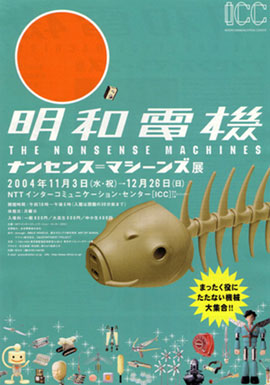 "I
guess that almost everybody is just sort of superficially
looking at my work," says Tosa from a conference room
after closing time of his ongoing exhibition "Maywa
Denki: The Nonsense Machines" at the NTT Intercommunication
Center in Hatsudai, Tokyo.
"I
guess that almost everybody is just sort of superficially
looking at my work," says Tosa from a conference room
after closing time of his ongoing exhibition "Maywa
Denki: The Nonsense Machines" at the NTT Intercommunication
Center in Hatsudai, Tokyo.
To look superficially at any of Tosa's work
would likely mean to miss the meaning. Once the surface "nonsense"
of his complicated machines, goofy toys, and self-playing
instruments has been put aside, serious commentary, humor,
and revelations about some of Tosa's innermost puzzles are
revealed. Through this, he is simultaneously taking a peek
inside himself and creating one of Japan's more recognizable
brand names for kitsch, a commodity he hopes to soon expand overseas.
"In Japan, the mainstream is dominated
by companies like Panasonic or Sony. But Maywa Denki works
in parallel. We are a niche market," Tosa laughs as he
moves to the empty seat to his right and thrusts his hands
in front of himself to demonstrate his point.
Indeed, Maywa Denki operates in an electrical
world all its own.
One of its earlier product lines is "Naki
Series," a lineup of 26 fish-themed manifestations. Attention
to design, careful craftsmanship, and a healthy dose of humor,
have contributed to these imaginative creations of glass,
steel,
and plastic: a xylophone in the shape of a fish
skeleton that contains light bulbs that light up - circuit
breaker included - when the keys are struck; a rotating harp
whose playing surface is a series of glass cups arranged along
a steel rod in a manner to fit the contours of a carp's body.
Most products are displayed with detailed shop
drawings and pictures to explain their use, if any. From drafting
table to fabrication, a product's development could take anywhere
from one week to three or four years.
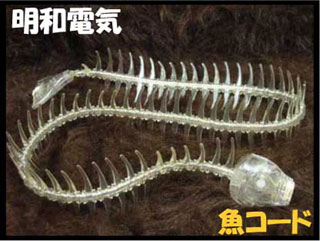 "Fish
Cord," an electrical extension cord complete with fish
head (male end) and tailfin (female end), is one of Maywa
Denki's signature pieces. Along with the very popular wind-up
instrument dolls in "Knockman Family," it is one
of the few works widely available for sale, priced at 3,800
yen.
"Fish
Cord," an electrical extension cord complete with fish
head (male end) and tailfin (female end), is one of Maywa
Denki's signature pieces. Along with the very popular wind-up
instrument dolls in "Knockman Family," it is one
of the few works widely available for sale, priced at 3,800
yen.
The origin of "Naki Series" goes
back to a nightmare about fish
Tosa experienced when he was young. This subsequent outpouring
of fish handiwork is a means for him to understand what has
become a personal psychosis.
Tosa, whose university schooling was in art,
likens this mental approach to the Japanese tradition of placing
okimono, small ivory carvings of samurai, mythic creatures,
or beautiful women popularized in the Meiji Period (1868-1912),
inside a home as a sign of spirituality.
"Japanese people believe that many things have life,"
he says. "For me, I believe that 'Fish Cord' has life."
Like his work, the thin-framed Tosa, in heavy
black glasses and bulky blue Maywa Denki "Zihotch"
time-announcing wristwatch (complete with rotary phone dial),
chooses his words very carefully when speaking about his products'
origins and his existential beliefs.
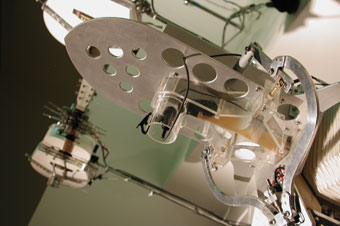 "'Why
do I make things?' That is a big question," he explains.
"But to me, this question is equivalent to other big
questions: 'What is life? What is God? What is space? Who
am I?' For me, if I can understand myself, I can make myself."
"'Why
do I make things?' That is a big question," he explains.
"But to me, this question is equivalent to other big
questions: 'What is life? What is God? What is space? Who
am I?' For me, if I can understand myself, I can make myself."
In summary: I make, therefore, I am.
His family has been a huge influence on Maywa
Denki, which is today composed of only Tosa and a few part-time
workers.
"Do it to conquer, take it to conquer,"
a pseudo-Darwinian phrase, is the family motto. Tosa's father,
Sakaichi, who founded Maywa Denki originally as a vacuum tube
company in 1969 only to suffer through bankruptcy proceedings
10 years later, used to tell his children after a large plate
of food had been placed at the center of the family dining
table: "If you don't get something (to eat), it is because
you are weak."
Emboldened by such an upbringing and, as Tosa
emphasizes, a strong imagination, he and his brother Masamichi
restarted Maywa Denki in 1993 under its current art motif.
In 2001, Masamichi retired for reasons unknown, leaving the
company to Tosa.
Tosa waves his right hand in an arcing motion
through the air and exclaims: "My brother is a strange
person! He is like a shooting star!"
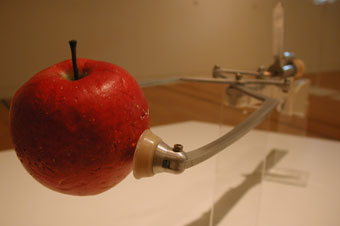 It
was his brother's purchase of a synthesizer, though, that
helped introduce Tosa to a new form of music.
Tosa found the sounds made by this instrument and those of
the Moog synthesizer featured on Isao Tomita's legendary debut record,
which he purchased during high school, to be absolutely shocking.
It was the first time he had heard machine-only music.
It
was his brother's purchase of a synthesizer, though, that
helped introduce Tosa to a new form of music.
Tosa found the sounds made by this instrument and those of
the Moog synthesizer featured on Isao Tomita's legendary debut record,
which he purchased during high school, to be absolutely shocking.
It was the first time he had heard machine-only music.
In middle school, Tosa played percussion in
the school brass band. This start eventually developed
into a pop
band heavily influenced by the pop of Duran Duran and
the clanking sounds of Kraftwerk.
"Tsukuba Series" is a group of robotic
instruments that reflects Tosa's vision of what today constitutes
music. To him, the computer and synthesizer are yesterday's
news.
"I think the iPod or the synthesizer is
information music," he says. "It is a wealth of
information only. I think music should be from materials.
It should have a material sound."
With Tosa's tongue not too far from his cheek,
many of the electronic instruments he created for "Tsukuba
Series" are more or less Rube Goldberg creations with
an anachronistic twist: electronics provide digital input
instructions and the physical contact of strings and drums
create an analog output.
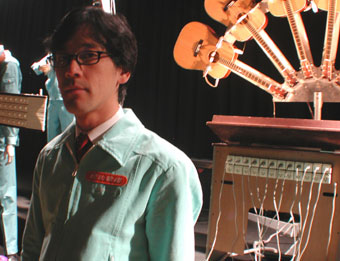 In
"Guitar-La," six guitars, fanned from their necks
vertically on a stand, are wired to an electric keyboard that
sends signals to hammers placed strategically above their strings.
"Taratter" is comprised of a pair of tap shoes with
wires running to hand-held control paddles that have switches
for activating the small hammers attached to the front of
each shoe. The latter product's description claims, "Comfortable
vibration cures foot problems."
In
"Guitar-La," six guitars, fanned from their necks
vertically on a stand, are wired to an electric keyboard that
sends signals to hammers placed strategically above their strings.
"Taratter" is comprised of a pair of tap shoes with
wires running to hand-held control paddles that have switches
for activating the small hammers attached to the front of
each shoe. The latter product's description claims, "Comfortable
vibration cures foot problems."
Throw in a few cymbals, strings, and various other thumping and tapping instruments and an entire digitally-driven analog orchestra emerges.
"Edelweiss Series," though, is where
Tosa shifts gears. It is his commentary on how
consumerism has swallowed post World War II Japan to the point of absurdity. "Compared to a century ago, Japanese
women today spend a lot of money and time trying to make
themselves look beautiful," Tosa explains. "Our
society has become so materialistic."
The story is a
twisted Orwellian tale of birth, rebellion, and death as told
through a text that accompanies more of his metal machines.
Tosa's writing at times takes on the feel of an anime script. Of "Poodles," a canine-shaped steel chomping machine, Tosa writes: "This deadly weapon was aimed at crushing the
females into pieces and symbolized the strong jaws that the
males had once possessed."
Other machines are less violent, but no less intriguing. "Deka-Savao" is a smooth white mask that separates
down the middle and splits laterally to reveal the wearer's
face. "Newton Gun" is a rifle with a pair of calipers
that releases an apple when the trigger is pulled.
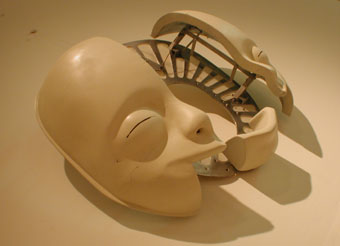 In
addition to his gadgets and ever-present blue shop uniform,
produced by fashion house agnes b., Maywa Denki has made a
name for itself in Japan through Tosa's appearances on such
television shows as Daredemo Picasso.
In
addition to his gadgets and ever-present blue shop uniform,
produced by fashion house agnes b., Maywa Denki has made a
name for itself in Japan through Tosa's appearances on such
television shows as Daredemo Picasso.
But Tosa wants to take Maywa Denki overseas
by establishing his brand in Europe and the U.S. As a start, Maywa Denki's first international "product demonstration" - the phrasing Tosa uses to more accurately describe his concerts - took place in Paris last year. As well, items from "Knockman Family" and "Fish Cord" have begun finding their way onto overseas-based Internet shopping sites. The next step will be to open complete overseas stores.
Eventually Tosa hopes to encounter a new philosophy
and develop new machines as a result. "Maywa Denki doesn't
want to be big," he explains. "Maywa Denki wants
to keep changing with the times."
Note: Ai Matsui contributed to this report
from the Tokyo bureau. "Maywa
Denki: The Nonsense Machines" runs through December
26th at the NTT
Intercommunication Center in Hatsudai, Tokyo.
The Inventor Series > Dr. Nakamats > Thanko > Maywa Denki

